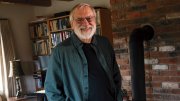 |
"Your wooden arm you hold outstretched to shake with passers-by." |
A friend works at the Berklee College of Music in Boston tells Primus that as part of a new image campaign, the school has created a tagline, or slogan, as in "Brylcreem: A Little Dab'll Do Ya." Berklee's is catchy: "Nothing Conservatory About It."
At last look, 505 taglines for institutions of higher learning appeared in an on-line database at https://www.stamats.com/resources/tagline-repository. A sampling:
The directional. Seton Hill University, Pennsylvania: "This Way Up."
The hortatory. University of Houston, Downtown: "Get a Life!"
The pecuniary. Amarillo College, Texas: "Give yourself a raise...Education Pays!"
The mysterious. California State University, Monterey Bay: "ExperienceFUSION."
The ominous. Boyce College, Kentucky: "The harvest is ready. Are you?"
The arguable (pace W.S. Gilbert). University of Toledo College of Law, Ohio: "The law is the true embodiment of everything that's excellent."
The sassy. University of Alaska, Fairbanks: "Latitude with Attitude."
The database has nothing for Harvard, but Boston Globe columnist Alex Beam, a Yalie, has invented a tagline for the University that has achieved considerable brand recognition in these parts: "World's Greatest University." ("When I use WGU," says Beam, "the intention is always ironical.")

Threads. Once there was a textile quartet composed of Harvard, Yale, Cambridge, and Oxford cloth, according to a widely cifrculated mail-order catalog, and Karen L. Edwards '78 of Durham, North Carolina, asks for details.
Primus has never heard of Harvard cloth, only Oxford. Nor has Barbara Meloni of University Archives, although an Internet search by her uncovers five references to it, all seemingly derived from a single source, alleging that a Scottish mill made the four cloths in the late nineteenth century. Nor has John T. Bethell '54, coauthor of Harvard A to Z, who notes that Oxford gray cloth reportedly was the default for Harvard students in the late eighteenth century. Nor has Robin McElheny, associate University archivist for programs, who passes along what B.H. Hall has to say about costume in College Words and Customs (1856): "Oxford-Mixed. Cloth such as is worn at the University of Oxford, England. The students in Harvard College were formerly required to wear this kind of cloth as their uniform. The color is given in the following passage: 'By black-mixed (called also Oxford-mixed) is understood, black with a mixture of not more than one twentieth, nor less than one twenty-fifth, part of white.' — Laws of Harvard College, 1826, page 25."
So, is the world's greatest fabric a fantasy? Or has some reader a swatch?

The coach's lesson. After stellar years coaching at Colgate and Western Maryland College, Richard C. Harlow became the first nonalumnus head football coach of the Crimson in 1935. An amateur expert in oology, the study of birds' eggs, he would serve as curator of oology at the Museum of Comparative Zoology as well.
Although a celebrated tactician, Harlow had just three winning seasons in his first eight years before taking a leave in 1943 to join the navy. In the December 2, 1938, number of this magazine, undergraduate columnist William R. Frye '40 reported: "Some time ago William H. Beehler Jr. '39, while looking over the picture of a [generic] football field printed on the cover of the Saturday Evening Post, noticed that it contained only 95 yards. Amused by this error, he dashed off a letter to the Post indignantly demanding the reason for this hoax, so baldly flaunted before the eyes of unsuspecting readers. Last week he received this answer: 'Dear Sir: Fact is, Dick Harlow asked us to shorten the field to 95 yards in the hope that his men could get somewhere against Yale at that length.'"
On the eve of the Yale game in 1938, The Second H Book of Harvard Athletics reports, Harlow concluded a team meeting with the singing of "Fair Harvard," which he led in his deep bass voice. About halfway through the second verse, he noticed that some players appeared to have forgotten the words. This triggered a tirade from the nonalumnus, according to a player who experienced it, to the effect that "the eleven men representing Harvard University tomorrow afternoon are representing the greatest institution of its kind in the world and, in this enviable capacity, they can be expected to know the words of 'Fair Harvard,' all three verses! Nobody plays tomorrow until they prove to me that this lesson is learned."
Next day in New Haven, before 60,000 spectators in the rain, Harlow's men did get somewhere against Yale, 7-0.





